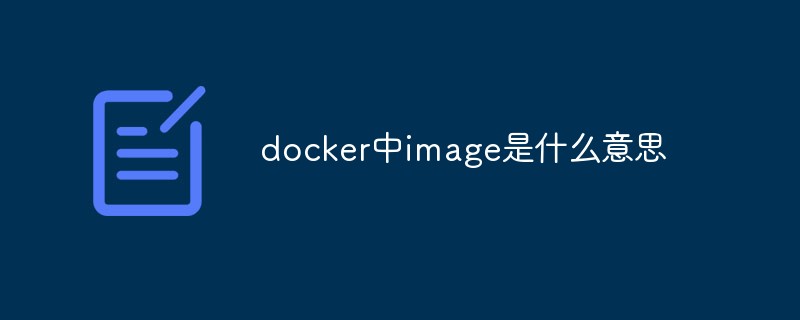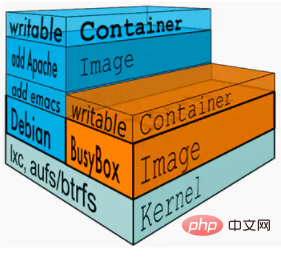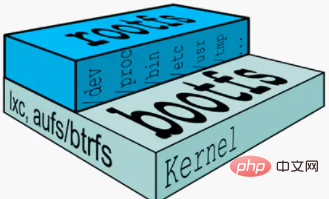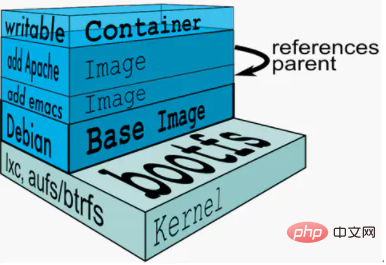What does image mean in docker
In docker, image means "mirror" and is a file system; image can mount several layers of directories together to form a virtual file system with the same directory structure as Linux. Docker passes these files In addition, the host's kernel provides a Linux virtual environment.

The operating environment of this tutorial: linux7.3 system, docker-1.13.1 version, Dell G3 computer.
What does image mean in docker
image Inside is a layer-by-layer file system called Union FS (Union File System).
United file system can mount several layers of directories together to form a virtual file system. The directory structure of the virtual file system is just like the directory structure of ordinary Linux. Docker provides a Linux virtual environment through these files and the kernel of the host.
Each layer of file system is called a layer. The joint file system can set three permissions for each layer of file system, read-only (readonly), read-write (readwrite) and write-out (whiteout-able). ), but each layer of the file system in the docker image is read-only.
When building an image, starting from the most basic operating system, each build operation is equivalent to making a layer of modifications and adding a layer of file system. Layer by layer, modifications to the upper layer will cover the visibility of the lower layer. This is easy to understand, just like the upper layer covers the bottom layer.
When you use it, you will only see a complete whole. You don't know how many layers there are, and you don't know what the modifications made to each layer are. The structure is similar to this:

#From a basic point of view, a typical Linux file system consists of bootfs and rootfs. bootfs (boot file system) mainly includes bootloader and kernel , bootloader is mainly used to boot and load the kernel. When the kernel is loaded into the memory, bootfs will be umounted.
rootfs (root file system) contains standard directories and files such as /dev, /proc, /bin, /etc, etc. in a typical Linux system. The following figure shows the most basic two-layer structure in the docker image. Different Linux distributions (such as ubuntu and CentOS) will have differences in the rootfs layer, reflecting the differences in distribution versions.

When traditional Linux loads bootfs, it will first set rootfs to read-only, and then change rootfs from read-only to read-write after system self-test, and then We can then perform read and write operations on rootfs.
But Docker will not change the read-only of rootfs to read-write after the bootfs self-test is completed. Instead, it will use union mount (a mounting mechanism of UnionFS) to change other layers in the image. Loaded onto the previous read-only rootfs layer, each layer is a rootfs structure and is read-only. Therefore, we cannot modify the layer in an existing image!
Only when we create a container, that is, instantiate the Docker image, the system will allocate an empty read-write rootfs to save the modifications we make. The changes saved by a layer are incremental, just like git.

#To sum up, image is actually a file system, which together with the host's kernel provides a virtual Linux environment for the program. When starting a docker container, docker will build a virtual Linux environment for the container based on the image.
Recommended learning: "docker video tutorial"
The above is the detailed content of What does image mean in docker. For more information, please follow other related articles on the PHP Chinese website!

Hot AI Tools

Undresser.AI Undress
AI-powered app for creating realistic nude photos

AI Clothes Remover
Online AI tool for removing clothes from photos.

Undress AI Tool
Undress images for free

Clothoff.io
AI clothes remover

Video Face Swap
Swap faces in any video effortlessly with our completely free AI face swap tool!

Hot Article

Hot Tools

Notepad++7.3.1
Easy-to-use and free code editor

SublimeText3 Chinese version
Chinese version, very easy to use

Zend Studio 13.0.1
Powerful PHP integrated development environment

Dreamweaver CS6
Visual web development tools

SublimeText3 Mac version
God-level code editing software (SublimeText3)

Hot Topics
 1655
1655
 14
14
 1414
1414
 52
52
 1307
1307
 25
25
 1254
1254
 29
29
 1228
1228
 24
24
 How to exit the container by docker
Apr 15, 2025 pm 12:15 PM
How to exit the container by docker
Apr 15, 2025 pm 12:15 PM
Four ways to exit Docker container: Use Ctrl D in the container terminal Enter exit command in the container terminal Use docker stop <container_name> Command Use docker kill <container_name> command in the host terminal (force exit)
 How to restart docker
Apr 15, 2025 pm 12:06 PM
How to restart docker
Apr 15, 2025 pm 12:06 PM
How to restart the Docker container: get the container ID (docker ps); stop the container (docker stop <container_id>); start the container (docker start <container_id>); verify that the restart is successful (docker ps). Other methods: Docker Compose (docker-compose restart) or Docker API (see Docker documentation).
 How to copy files in docker to outside
Apr 15, 2025 pm 12:12 PM
How to copy files in docker to outside
Apr 15, 2025 pm 12:12 PM
Methods for copying files to external hosts in Docker: Use the docker cp command: Execute docker cp [Options] <Container Path> <Host Path>. Using data volumes: Create a directory on the host, and use the -v parameter to mount the directory into the container when creating the container to achieve bidirectional file synchronization.
 How to check the name of the docker container
Apr 15, 2025 pm 12:21 PM
How to check the name of the docker container
Apr 15, 2025 pm 12:21 PM
You can query the Docker container name by following the steps: List all containers (docker ps). Filter the container list (using the grep command). Gets the container name (located in the "NAMES" column).
 How to start mysql by docker
Apr 15, 2025 pm 12:09 PM
How to start mysql by docker
Apr 15, 2025 pm 12:09 PM
The process of starting MySQL in Docker consists of the following steps: Pull the MySQL image to create and start the container, set the root user password, and map the port verification connection Create the database and the user grants all permissions to the database
 How to start containers by docker
Apr 15, 2025 pm 12:27 PM
How to start containers by docker
Apr 15, 2025 pm 12:27 PM
Docker container startup steps: Pull the container image: Run "docker pull [mirror name]". Create a container: Use "docker create [options] [mirror name] [commands and parameters]". Start the container: Execute "docker start [Container name or ID]". Check container status: Verify that the container is running with "docker ps".
 How to update the image of docker
Apr 15, 2025 pm 12:03 PM
How to update the image of docker
Apr 15, 2025 pm 12:03 PM
The steps to update a Docker image are as follows: Pull the latest image tag New image Delete the old image for a specific tag (optional) Restart the container (if needed)
 How to view logs from docker
Apr 15, 2025 pm 12:24 PM
How to view logs from docker
Apr 15, 2025 pm 12:24 PM
The methods to view Docker logs include: using the docker logs command, for example: docker logs CONTAINER_NAME Use the docker exec command to run /bin/sh and view the log file, for example: docker exec -it CONTAINER_NAME /bin/sh ; cat /var/log/CONTAINER_NAME.log Use the docker-compose logs command of Docker Compose, for example: docker-compose -f docker-com




